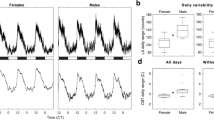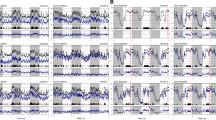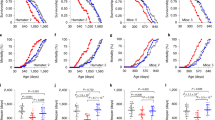Abstract
Impairment of one or more parameters of circadian rhythms (CR) of body temperature (BT) and locomotor activity (LMA) are considered among the hallmarks of mammalian aging. These alterations are frequently used as markers for imminent death in laboratory mice. However, there are still contradictory data for particular strains and it is also uncertain which changes might predict senescence changes later in life, including the force of mortality. In the present paper we use telemetry to study LMA and CR of BT during aging of BALB/c mice. At our knowledge this is the first time that CR of BT and LMA are investigated in this strain in a range of age covering the whole lifespan, from young adult up to very old age. CR of BT was analyzed with a cosine model using a cross sectional approach and follow-up measurements. The results show that BT, LMA, amplitude, goodness-of-fit (GoF) to circadian cycle of temperature decrease with different shapes during chronological age. Moreover, we found that the % change of amplitude and BT in early life (5–19 months) can predict the remaining lifespan of the mice. Later in life (22–32 months), best predictors are single measurements of LMA and GoF. The results of this study also offer potential measures to rapidly identifying freely unrestrained mice with the worst longitudinal outcome and against which existing or novel biomarkers and treatments may be assessed.

Similar content being viewed by others
References
Andrews MT (2007) Advances in molecular biology of hibernation in mammals. Bioessays 29:431–440
Anisimov VN, Bartke A (2013) The key role of growth hormone-insulin-IGF-1 signaling in aging and cancer. Crit Rev Oncol Hematol 87:201–223
Anisimov VN, Zabezhinski MA, Rossolini G, Zaia A, Piantanelli A, Basso A, Piantanelli L (2001) Long-live BALB/c-nu mice, II. Spontaneous tumors and other pathologies. Mech Ageing Dev 122:477–489
Bai H, Islam MN, Kuroki H, Honda K, Wakasugi C (1995) Deaths due to heat waves during the summer of 1994 in Osaka Prefecture, Japan. Nippon Hoigaku Zasshi 49:265–274
Balmagiya T, Rozovski SJ (1983) Age-related changes in thermoregulation in male albino rats. Exp Gerontol 18:199–210
Bass J (2012) Circadian topology of metabolism. Nature 491:348–356
Basso A, Piantanelli L (2002) Influence of age on circadian rhythms of adrenoceptors in brain cortex, heart and submandibular glands of BALB/c mice: when circadian studies are not only useful but necessary. Exp Gerontol 37:1441–1450
Benstaali C, Bogdan A, Touitou Y (2002) Effect of a short photoperiod on circadian rhythms of body temperature and motor activity in old rats. Pflugers Arch 444:73–79
Blatteis CM (2012) Age-dependent changes in temperature regulation—a mini review. Gerontology 58:289–295
Brock MA (1991) Chronobiology and aging. J Am Geriatr Soc 39:74–91
Bronson RT, Lipman RD (1993) FRAR course on laboratory approaches to aging. The role of pathology in rodent experimental gerontology. Aging (Milano) 5:253–257
Conti B, Sanchez-Alavez M, Winsky-Sommerer R, Morale MC, Lucero J, Brownell S, Fabre V, Huitron-Resendiz S, Henriksen S, Zorrilla EP, de Lecea L, Bartfai T (2006) Transgenic mice with a reduced core body temperature have an increased life span. Science 314:825–828
Czeisler CA, Dumont M, Duffy JF, Steinberg JD, Richardson GS, Brown EN, Sanchez R, Rios CD, Ronda JM (1992) Association of sleep–wake habits in older people with changes in output of circadian pacemaker. Lancet 340:933–936
Degroot DW, Kenney WL (2007) Impaired defense of core temperature in aged humans during mild cold stress. Am J Physiol Regul Integr Comp Physiol 292:R103–R108
Duffy PH, Feuers RJ, Pipkin JL, Turturro A (1997) Hart RW. Age and temperature related changes in behavioral and physiological performance in the Peromyscus leucopus mouse. Mech Ageing Dev 95:43–61
Eleftheriou BE (1975) Changes with age in protein-bound iodine (PBI) and body temperature in the mouse. J Gerontol 30:417–421
Estler CJ (1971) Efficiency of thermoregulation in acutely cold exposed young and old mice. Life Sci 10:1291–1298
Fontana L, Klein S, Holloszy JO (2010) Effects of long-term calorie restriction and endurance exercise on glucose tolerance, insulin action, and adipokine production. Age (Dordr). 32(1):97–108
Garinis GA, van der Horst GT, Vijg J, Hoeijmakers JH (2008) DNA damage and ageing: new-age ideas for an age-old problem. Nat Cell Biol 10:1241–1247
Gaskill BN, Gordon CJ, Pajor EA, Lucas JR, Davis JK, Garner JP (2013) Impact of nesting material on mouse body temperature and physiology. Physiol Behav 110–111:87–95
Gonzales P, Rikke BA (2010) Thermoregulation in mice exhibits genetic variability early in senescence. Age (Dordr) 32:31–37
Goodrick CL (1975) Lifespan and the inheritance of longevity of inbred mice. J Gerontol 30:257–263
Habicht GS (1981) Body temperature in normal and endotoxintreated mice of different ages. Mech Ageing Dev 16:97–104
Hauck SJ, Hunter WS, Danilovich N, Kopchick JJ, Bartke A (2001) Reduced levels of thyroid hormones, insulin, and glucose, and lower body core temperature in the growth hormone receptor/binding protein knockout mouse. Exp Biol Med (Maywood) 226:552–558
Helwig BG, Ward JA, Blaha MD, Leon LR (2012) Effect of intraperitoneal radiotelemetry instrumentation on voluntary wheel running and surgical recovery in mice. J Am Assoc Lab Anim Sci 51:600–608
Hunter W, Croson W, Bartke A, Gentry M, Meliska C (1999) Low body temperature in long-lived Ames dwarf mice at rest and during stress. Physiol Behav 67:433–437
Keil G, Cummings E, de Magalhães JP (2015) Being cool: how body temperature influences ageing and longevity. Biogerontology 16:383–397
Kenney WL, Munce TA (2003) Invited review: aging and human temperature regulation. J Appl Physiol 95:2598–2603
Klemfuss H, Clopton PL (1993) Seeking tau: a comparison of six methods. J Interdisclip Cycle Res 24:1–16
Knight EM, Brown TM, Gümüsgöz S, Smith JC, Waters EJ, Allan SM, Lawrence CB (2013) Age-related changes in core body temperature and activity in triple-transgenic Alzheimer’s disease (3xTgAD) mice. Dis Model Mech 6:160–170
Liu H, Graber TG, Ferguson-Stegall L, Thompson LV (2014) Clinically relevant frailty index for mice. J Gerontol A Biol Sci Med Sci 69:1485–1491
Mailloux A, Benstaali C, Bogdan A, Auzeby A, Touitou Y (1999) Body temperature and locomotor activity as marker rhythms of aging of the circadian system in rodents. Exp Gerontol 34:733–740
McDonald RB, Murtagh CM, Horwitz BA (1994) Age and gender effects on glucose utilization in skeletal muscle and brown adipose tissue of cold-exposed rats. Proc Soc Exp Biol Med 207:102–109
McDonald RB, Hoban-Higgins TM, Ruhe RC, Fuller CA, Horwitz BA (1999) Alterations in endogenous circadian rhythm of core temperature in senescent Fischer 344 rats. Am J Physiol 276:R824–R830
McLaren A (1961) Some causes of variation of body temperature in mice. Q J Exp Physiol Cogn Med Sci 46:38–45
Miller RA, Nadon NL (2000) Principles of animal use for gerontological research. J Gerontol A Biol Sci Med Sci 55:B117–B123
Monk TH (1991) Sleep and circadian rhythms. Exp Gerontol 26:233–243
Monk TH, Buysse DJ, Reynolds CF III, Kupfer DJ, Houck PR (1995) Circadian temperature rhythms of older people. Exp Gerontol 30:455–474
Nelson KP, Marks NL, Heyen JR, Johnson RW (1999) Behavior of adult and aged mice before and after central injection of interleukin-1beta. Physiol Behav 66:673–679
Piantanelli L, Rossolini G (1992) Basso A. Biomarkers of aging and survival kinetics. Ann N Y Acad Sci 673:9–15
Ray MA, Johnston NA, Verhulst S, Trammell RA, Toth LA (2010) Identification of markers for imminent death in mice used in longevity and aging research. J Am Assoc Lab Anim Sci 49:282–288
Refinetti R, Ma H, Satinoff E (1990) Body temperature rhythms, cold tolerance, and fever in young and old rats of both genders. Exp Gerontol 25:533–543
Reinberg A, Smolensky MH (1983) Investigative methodology for chronobiology. In: Reinberg A, Smolensky MH (eds) Biological rhythms and medicine. Springer, New York, pp 23–46
Reynolds MA, Ingram DK, Talan M (1985) Relationship of body temperature stability to mortality in aging mice. Mech Ageing Dev 30:143–152
Rikke BA, Johnson TE (2007) Physiological genetics of dietary restriction: uncoupling the body temperature and body weight responses. Am J Physiol Regul Integr Comp Physiol 293:R1522–R1527
Sanchez-Alavez M, Tabarean IV, Osborn O, Mitsukawa K, Schaefer J, Dubins J, Holmberg KH, Klein I, Klaus J, Gomez LF, Kolb H, Secrest J, Jochems J, Myashiro K, Buckley P, Hadcock JR, Eberwine J, Conti B, Bartfai T (2010) Insulin causes hyperthermia by direct inhibition of warm-sensitive neurons. Diabetes 59:43–50
Sanchez-Alavez M, Alboni S, Conti B (2011) Sex- and age-specific differences in core body temperature of C57Bl/6 mice. Age (Dordr) 33:89–99
Schonholz DH, Osborn CM (1949) Temperature studies in dwarf mice. Anat Rec 105:605
Soare A, Cangemi R, Omodei D, Holloszy JO, Fontana L (2011) Long-term calorie restriction, but not endurance exercise, lowers core body temperature in humans. Aging (Albany NY). 3:374–379
Staats J (1980) Standardized nomenclature for inbred strains of mice: seventh listing for the International Committee on Standardized Genetic Nomenclature for Mice. Cancer Res 40:2083–2128
Storer JB (1966) Longevity and gross pathology at death in 22 inbred strains of mice. J Gerontol 21:404–409
Sturm J, Weinert H, Weinert D (2000) Age-dependent changes in the stability of the daily activity rhythms of laboratory mice. Z Säugetierkunde 65:21–32
Talan M (1984) Body temperature of C57BL/6J mice with age. Exp Gerontol 19:25–29
Talan MI, Engel BT, Whitaker JR (1985) A longitudinal study of tolerance to cold stress among C57BL/6J mice. J Gerontol 40:8–14
Touitou Y, Reinberg A, Bogdan A, Auzeby A, Beck H, Touitou C (1986) Agerelated changes in both circadian and seasonal rhythms of rectal temperature with special reference to senile dementia of Alzheimer type. Gerontology 32:110–118
Van Someren EJ, Raymann RJ, Scherder EJ, Daanen HA (2002) Swaab DF. Circadian and age-related modulation of thermoreception and temperature regulation: mechanisms and functional implications. Ageing Res Rev 1:721–778
Vitiello MV, Smallwood RG, Avery DH, Pascualy RA, Martin DC, Prinz PN (1986) Circadian temperature rhythms in young adult and aged men. Neurobiol Aging 7:97–100
Volicer L, Harper DG, Stopa EG (2012) Severe impairment of circadian rhythm in Alzheimer’s disease. J Nutr Health Aging 16:888–890
Walford RL, Spindler SR (1997) The response to calorie restriction in mammals shows features also common to hibernation: a cross-adaptation hypothesis. J Gerontol Ser A 52(4):B179–B183
Weinert D, Waterhouse J (2007) The circadian rhythm of core temperature: effects of physical activity and aging. Physiol Behav 90:246–256
Weitzman ED, Moline ML, Czeisler CA, Zimmerman JC (1982) Chronobiology of aging: temperature, sleep–wake rhythms and entrainment. Neurobiol Aging 3:299–309
Witting W, Mirmiran M (1997) A mathematical method for studying the endogenous component of the circadian temperature rhythm and the effect of aging. Biol Rhythm Res 28:216–229
Acknowledgments
The authors thanks Dr. Tiziana Casoli and Dr. Anna Piantanelli for kindly reading the manuscript.
Author information
Authors and Affiliations
Corresponding author
Electronic supplementary material
Below is the link to the electronic supplementary material.
Rights and permissions
About this article
Cite this article
Basso, A., Del Bello, G., Piacenza, F. et al. Circadian rhythms of body temperature and locomotor activity in aging BALB/c mice: early and late life span predictors. Biogerontology 17, 703–714 (2016). https://doi.org/10.1007/s10522-016-9635-y
Received:
Accepted:
Published:
Issue Date:
DOI: https://doi.org/10.1007/s10522-016-9635-y




